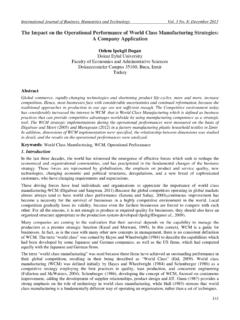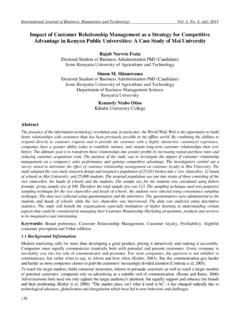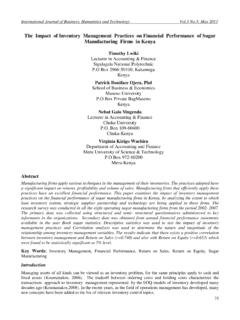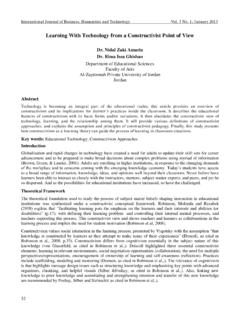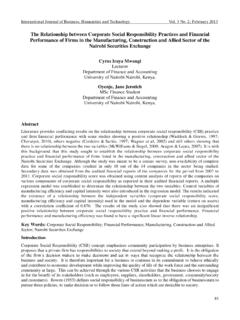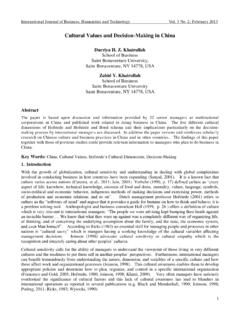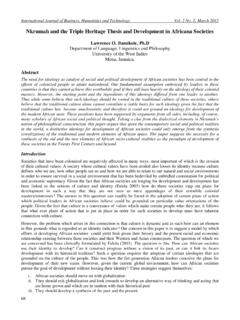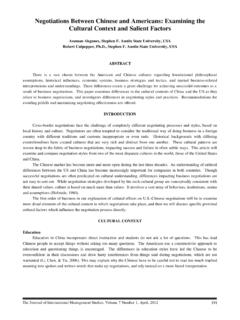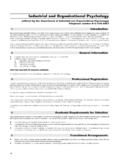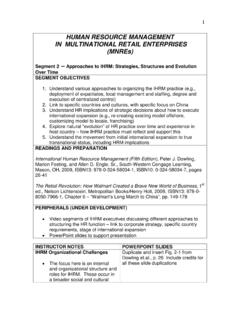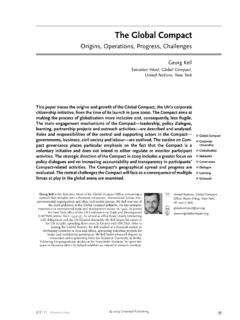Transcription of International Business Negotiations: Culture, Dimensions ...
1 International Journal of Business , Humanities and Technology Vol. 3 No. 7; September 2013 91 International Business negotiations : culture , Dimensions , Context K stutis Peleckis Vilnius Gediminas Technical University Saul tekio al. 11, LT 10223 Vilnius, Lithuania Abstract Context of the negotiations at the International level is faced with the differences between various cultures: a long-term attitude towards communication, the power placement, the uncertainties avoiding, emotional differences between the negotiating parties and others.
2 These and other differences in cross-cultural Dimensions can influence the process of negotiations between the representatives of different cultures in the negotiations . There may happen in a variety of misunderstandings in negotiations and between the two parties of the same culture , while the process of preparing for the talks with different cultures require The article discusses cultural Dimensions , their effect on negotiations . The analysis performed the global scientific literature, cultural Dimensions and presented their comparison. There are investigated International Business negotiation context and cognition aspects also.
3 Paper includes suggestions for further research of International negotiations . Key words: Business negotiations , cultural dimension of negotiation, context of International negotiations , International negotiation context, the knowledge and the key elements of the negotiating parties incompatibility. 1. Introduction Relevance. The International Business representatives from different countries when preparing for a Business partnership or the transactions often are analyzing traditions, differences, and properties of other countries. Businesses in order to facilitate Business process are trying to adjust to the peculiarities of the other party.
4 In order to achieve this can be analyzed cultural Dimensions which can convey the essential incompatibilities between the parties. Analyzing incompatibilities between different cultures there can be used the analysis of Hofstede's cultural Dimensions . This can be very useful in the design of International Business negotiation processes because it can convey the differences between the different cultural Dimensions among the negotiating parties. Intercultural differences Dimensions may influence the negotiation process between representatives of different cultures. There may be different understanding of the various symbols or actions in different cultures.
5 So, before the start of International negotiations it is necessary to get acquainted with other cultural features, or even to hire mediator who knows this culture well. In special literature it is recommended to communicate in the International negotiations with intermediaries who are familiar with the culture of the other party and having legal background, because they may have the knowledge about cultural and legal aspects in the negotiations about the other party. The problem - in the scientific literature are not sufficiently investigated effects of different cultures to the course of the negotiation process and the final results.
6 The object of investigation - The processes of International Business negotiations . The aim - To make a comparative analysis of world literature and practice in International Business negotiations . Research methods - The systematic, comparative, logical analysis and synthesis of the scientific literature. 2. Cultural Dimensions Analysis Context of the negotiations at the International level is faced with the differences between various cultures: a long-term attitude towards communication, the power placement, the uncertainties avoiding, emotional differences between the negotiating parties and others.
7 These and other differences in cross-cultural Dimensions can influence the process of negotiations between the representatives of different cultures. May vary understanding of various symbols or actions in different cultures. Impact of negotiation strategies for the final results are significant, therefore, in the preparation phase of negotiations it is necessary to examine the cultural Dimensions of the other party. In special literature are observed that for the negotiating team during negotiations with other cultures is needed to adapt. Therefore, it is necessary not only to get acquainted with other's cultural Dimensions , but also with the existing differences, which may arise difficulties in communicating.
8 Center for Promoting Ideas, USA 92 One should also to predict potential cross-cultural conflicts, misunderstandings and the measures to prevent them. Therefore, in the article are analyzed cultural Dimensions described in the world literature. In scientific literature can be found a lot of the concepts of culture and they are very different. So in the article will be presented contributions of several authors. culture is a set of beliefs and values (Javidan and House, 2001), Hosted By (1991) write that culture is the collective programming of thinking that distinguishes members of one group from the other in terms of values forms, beliefs, assumptions, expectations, perceptions and behavior.
9 Cultural values are desired practice and cultural practice of people, show people's perception of everything what is being done in their countries (House et al., 2002). It can be argued that culture is a set of shared attitudes, values, goals, and practices, according to which described institution, organization or group affects all aspects of society and human life (Gaygisiz 2013). culture is defined as a constellation of slightly interconnected values, practices and norms, by which are shared related group of people of a certain nation (Chiu et al. 2010). culture consists of a set of values and practices that have been developed and maintained from generation to generation (Markus and Kitayama 1999).
10 culture reflects the values and thinking patterns, feelings, emotions, and behavior of identifiable groups. Though many nations have a modern and civilized-developed infrastructure, culture shows how human civilization interacts among each other (Pitta et al. 1999). That author states that the primary cultural values are transmitted by educational process of children of that culture members, in the process of socialization, education, and religion. There are also secondary factors which influence ethical behavior, they cover the differences in the laws between nations, adopted in human resource management systems, organizational cultures, and professional cultures, and codes of conduct (Pitta et al.)
